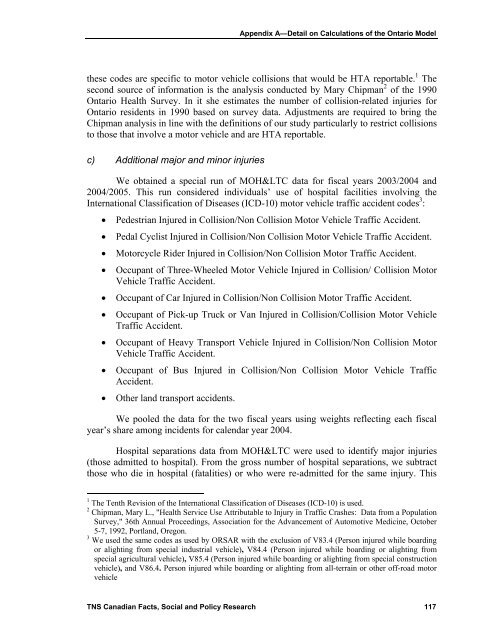Keith Vodden Dr. Douglas Smith - Transports Canada
Keith Vodden Dr. Douglas Smith - Transports Canada
Keith Vodden Dr. Douglas Smith - Transports Canada
Create successful ePaper yourself
Turn your PDF publications into a flip-book with our unique Google optimized e-Paper software.
Appendix A—Detail on Calculations of the Ontario Model<br />
these codes are specific to motor vehicle collisions that would be HTA reportable. 1 The<br />
second source of information is the analysis conducted by Mary Chipman 2 of the 1990<br />
Ontario Health Survey. In it she estimates the number of collision-related injuries for<br />
Ontario residents in 1990 based on survey data. Adjustments are required to bring the<br />
Chipman analysis in line with the definitions of our study particularly to restrict collisions<br />
to those that involve a motor vehicle and are HTA reportable.<br />
c) Additional major and minor injuries<br />
We obtained a special run of MOH<C data for fiscal years 2003/2004 and<br />
2004/2005. This run considered individuals’ use of hospital facilities involving the<br />
International Classification of Diseases (ICD-10) motor vehicle traffic accident codes 3 :<br />
• Pedestrian Injured in Collision/Non Collision Motor Vehicle Traffic Accident.<br />
• Pedal Cyclist Injured in Collision/Non Collision Motor Vehicle Traffic Accident.<br />
• Motorcycle Rider Injured in Collision/Non Collision Motor Traffic Accident.<br />
• Occupant of Three-Wheeled Motor Vehicle Injured in Collision/ Collision Motor<br />
Vehicle Traffic Accident.<br />
• Occupant of Car Injured in Collision/Non Collision Motor Traffic Accident.<br />
• Occupant of Pick-up Truck or Van Injured in Collision/Collision Motor Vehicle<br />
Traffic Accident.<br />
• Occupant of Heavy Transport Vehicle Injured in Collision/Non Collision Motor<br />
Vehicle Traffic Accident.<br />
• Occupant of Bus Injured in Collision/Non Collision Motor Vehicle Traffic<br />
Accident.<br />
• Other land transport accidents.<br />
We pooled the data for the two fiscal years using weights reflecting each fiscal<br />
year’s share among incidents for calendar year 2004.<br />
Hospital separations data from MOH<C were used to identify major injuries<br />
(those admitted to hospital). From the gross number of hospital separations, we subtract<br />
those who die in hospital (fatalities) or who were re-admitted for the same injury. This<br />
1 The Tenth Revision of the International Classification of Diseases (ICD-10) is used.<br />
2 Chipman, Mary L., "Health Service Use Attributable to Injury in Traffic Crashes: Data from a Population<br />
Survey," 36th Annual Proceedings, Association for the Advancement of Automotive Medicine, October<br />
5-7, 1992, Portland, Oregon.<br />
3 We used the same codes as used by ORSAR with the exclusion of V83.4 (Person injured while boarding<br />
or alighting from special industrial vehicle), V84.4 (Person injured while boarding or alighting from<br />
special agricultural vehicle), V85.4 (Person injured while boarding or alighting from special construction<br />
vehicle), and V86.4. Person injured while boarding or alighting from all-terrain or other off-road motor<br />
vehicle<br />
TNS Canadian Facts, Social and Policy Research 117
















